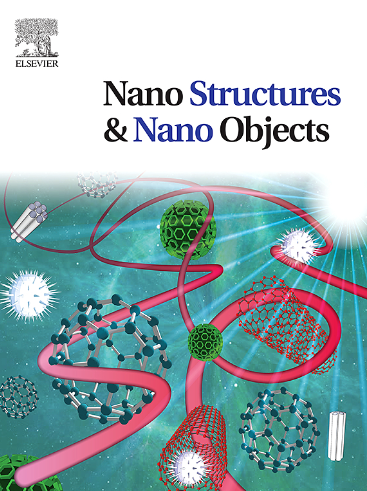通过统计实验设计的长春碱负载氧化锌纳米颗粒的精密工程
IF 5.45
Q1 Physics and Astronomy
引用次数: 0
摘要
多功能氧化锌纳米颗粒(ZnONPs)用于长春花碱(VB)的递送是纳米医学的新途径。然而,这种组合的合成、特点及其在生物医学应用中的潜力还有待探索。鉴于其具有良好的治疗前景,全面的实验方法对于实现具有治疗价值的VB-ZnONPs的稳健配方至关重要。因此,本研究旨在采用统计实验设计优化长春花碱(VB)负载ZnONPs的合成,并评估其在靶向给药和抗菌方面的应用潜力。采用Box-Behnken设计(BBD)法,考察了搅拌温度、搅拌速度和干燥温度等关键工艺参数对平均粒径、ZP和捕集效率的影响,确定了最佳合成条件。在最佳合成条件下,VB-ZnONPs实现意味着粒子大小、ZP 159 EE ±0.78 nm, −16.5±0.61 mV和92.8±0.02 %,分别从软件与预测值一致。紫外可见光谱显示,VB和ZnONPs分别在270 nm和344 nm处出现吸光度峰,证实了VB-ZnONPs的形成。此外,通过傅里叶变换红外光谱对VB和ZnO官能团的检测,证实了VB- znonps的合成。透射电子显微镜证实了不规则和准球形颗粒,能量色散x射线光谱(EDX)显示了锌、氧和碳的元素分布。通过热重分析验证了VB-ZnONPs的稳定性。x射线衍射图显示,VB-ZnONPs的晶粒尺寸为22.9 nm,具有六方纤锌矿结构。VB- znonps表现出对VB的ph敏感释放,表明有靶向递送到肿瘤微环境的潜力。此外,它们以剂量依赖的方式阻止革兰氏阳性细菌(金黄色葡萄球菌、表皮葡萄球菌和枯草芽孢杆菌)的生长。这些研究结果强调了采用统计方法优化VB-ZnONPs配方的重要性以及VB-ZnONPs在生物医学应用中的潜力。本文章由计算机程序翻译,如有差异,请以英文原文为准。
Precision engineering of vinblastine-loaded zinc oxide nanoparticles through statistical experimental design
The application of multifunctional zinc oxide nanoparticles (ZnONPs) for the delivery of vinblastine (VB) represents a novel approach in nanomedicine. However, the synthesis of this combination, its characteristics and potential in biomedical applications have yet to be explored. Given its promising therapeutic prospects, a holistic experimental approach is essential to achieve a robust formulation of VB-ZnONPs with therapeutic values. Hence, this study aimed to employ statistical experimental design to optimize the synthesis of vinblastine (VB)-loaded ZnONPs and assess their potential in targeted drug delivery and antimicrobial applications. The effect of the critical process parameters such as stirring temperature, stirring speed and drying temperature on the mean particle size, zeta potential (ZP), and entrapment efficiency (EE) were evaluated and the optimal synthesis conditions were determined with Box-Behnken Design (BBD). Under the optimal synthesis conditions, VB-ZnONPs achieved mean particle size, ZP and EE of 159 ± 0.78 nm, −16.5 ± 0.61 mV and 92.8 ± 0.02 %, respectively, consistent with the predicted values from the software. UV–visible spectroscopy revealed an absorbance peak at 270 nm for VB and 344 nm for ZnONPs, confirming the formation of VB-ZnONPs. Further, the synthesis of VB-ZnONPs was affirmed through the detection of VB and ZnO functional groups in the Fourier transform infrared spectroscopy. Transmission electron microscopy confirmed irregular and quasi-spherical shaped particles, while energy-dispersive X-ray spectroscopy (EDX) displayed the elemental distribution of zinc, oxygen and carbon. The stability of VB-ZnONPs was verified through thermogravimetric analysis. X-ray diffraction pattern revealed that VB-ZnONPs possessed a crystallite size of 22.9 nm and a hexagonal wurtzite structure. VB-ZnONPs demonstrated pH-sensitive release of VB, indicating potential for targeted delivery to tumor microenvironment. Moreover, they prevented the growth of Gram-positive bacteria (Staphylococcus aureus, Staphylococcus epidermidis and Bacillus subtilis) in a dose-dependent manner. These research findings underscore the significance of employing a statistical approach in optimizing the formulation of VB-ZnONPs and the potential of VB-ZnONPs in biomedical applications.
求助全文
通过发布文献求助,成功后即可免费获取论文全文。
去求助
来源期刊

Nano-Structures & Nano-Objects
Physics and Astronomy-Condensed Matter Physics
CiteScore
9.20
自引率
0.00%
发文量
60
审稿时长
22 days
期刊介绍:
Nano-Structures & Nano-Objects is a new journal devoted to all aspects of the synthesis and the properties of this new flourishing domain. The journal is devoted to novel architectures at the nano-level with an emphasis on new synthesis and characterization methods. The journal is focused on the objects rather than on their applications. However, the research for new applications of original nano-structures & nano-objects in various fields such as nano-electronics, energy conversion, catalysis, drug delivery and nano-medicine is also welcome. The scope of Nano-Structures & Nano-Objects involves: -Metal and alloy nanoparticles with complex nanostructures such as shape control, core-shell and dumbells -Oxide nanoparticles and nanostructures, with complex oxide/metal, oxide/surface and oxide /organic interfaces -Inorganic semi-conducting nanoparticles (quantum dots) with an emphasis on new phases, structures, shapes and complexity -Nanostructures involving molecular inorganic species such as nanoparticles of coordination compounds, molecular magnets, spin transition nanoparticles etc. or organic nano-objects, in particular for molecular electronics -Nanostructured materials such as nano-MOFs and nano-zeolites -Hetero-junctions between molecules and nano-objects, between different nano-objects & nanostructures or between nano-objects & nanostructures and surfaces -Methods of characterization specific of the nano size or adapted for the nano size such as X-ray and neutron scattering, light scattering, NMR, Raman, Plasmonics, near field microscopies, various TEM and SEM techniques, magnetic studies, etc .
 求助内容:
求助内容: 应助结果提醒方式:
应助结果提醒方式:


